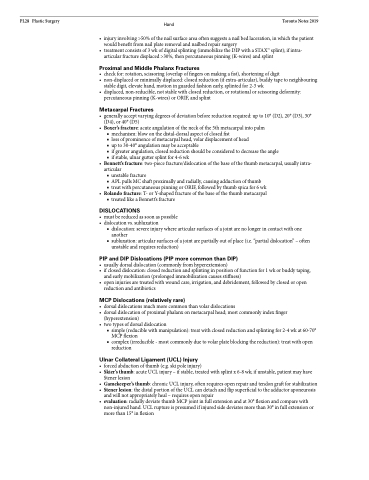Page 1150 - TNFlipTest
P. 1150
PL28 Plastic Surgery Hand Toronto Notes 2019
• injuryinvolving>50%ofthenailsurfaceareaoftensuggestsanailbedlaceration,inwhichthepatient would benefit from nail plate removal and nailbed repair surgery
• treatmentconsistsof3wkofdigitalsplinting(immobilizetheDIPwithaSTAXTMsplint);ifintra- articular fracture displaced >30%, then percutaneous pinning (K-wires) and splint
Proximal and Middle Phalanx Fractures
• checkfor:rotation,scissoring(overlapoffingersonmakingafist),shorteningofdigit
• non-displacedorminimallydisplaced:closedreduction(ifextra-articular),buddytapetoneighbouring
stable digit, elevate hand, motion in guarded fashion early, splinted for 2-3 wk
• displaced,non-reducible,notstablewithclosedreduction,orrotationalorscissoringdeformity:
percutaneous pinning (K-wires) or ORIF, and splint
Metacarpal Fractures
• generallyacceptvaryingdegreesofdeviationbeforereductionrequired:upto10°(D2),20°(D3),30° (D4), or 40° (D5)
• Boxer’sfracture:acuteangulationoftheneckofthe5thmetacarpalintopalm ■ mechanism: blow on the distal-dorsal aspect of closed fist
■ loss of prominence of metacarpal head, volar displacement of head
■ up to 30-40° angulation may be acceptable
■ if greater angulation, closed reduction should be considered to decrease the angle
■ if stable, ulnar gutter splint for 4-6 wk
• Bennett’sfracture:two-piecefracture/dislocationofthebaseofthethumbmetacarpal,usuallyintra-
articular
■ unstable fracture
■ APL pulls MC shaft proximally and radially, causing adduction of thumb
■ treat with percutaneous pinning or ORIF, followed by thumb spica for 6 wk
• Rolandofracture:T-orY-shapedfractureofthebaseofthethumbmetacarpal ■ treated like a Bennett’s fracture
DISLOCATIONS
• mustbereducedassoonaspossible • dislocationvs.subluxation
■ dislocation: severe injury where articular surfaces of a joint are no longer in contact with one another
■ subluxation: articular surfaces of a joint are partially out of place (i.e. “partial dislocation” – often unstable and requires reduction)
PIP and DIP Dislocations (PIP more common than DIP)
• usuallydorsaldislocation(commonlyfromhyperextension)
• ifcloseddislocation:closedreductionandsplintinginpositionoffunctionfor1wkorbuddytaping,
and early mobilization (prolonged immobilization causes stiffness)
• openinjuriesaretreatedwithwoundcare,irrigation,anddebridement,followedbyclosedoropen
reduction and antibiotics
MCP Dislocations (relatively rare)
• dorsaldislocationsmuchmorecommonthanvolardislocations
• dorsaldislocationofproximalphalanxonmetacarpalhead;mostcommonlyindexfinger
(hyperextension)
• twotypesofdorsaldislocation
■ simple (reducible with manipulation): treat with closed reduction and splinting for 2-4 wk at 60-70° MCP flexion
■ complex (irreducible - most commonly due to volar plate blocking the reduction): treat with open reduction
Ulnar Collateral Ligament (UCL) Injury
• forcedabductionofthumb(e.g.skipoleinjury)
• Skier’sthumb:acuteUCLinjury–ifstable,treatedwithsplintx6-8wk;ifunstable,patientmayhave
Stener lesion
• Gamekeeper’sthumb:chronicUCLinjury,oftenrequiresopenrepairandtendongraftforstabilization
• Stenerlesion:thedistalportionoftheUCLcandetachandflipsuperficialtotheadductoraponeurosis
and will not appropriately heal – requires open repair
• evaluation:radiallydeviatethumbMCPjointinfullextensionandat30°flexionandcomparewith
non-injured hand. UCL rupture is presumed if injured side deviates more than 30° in full extension or more than 15° in flexion


